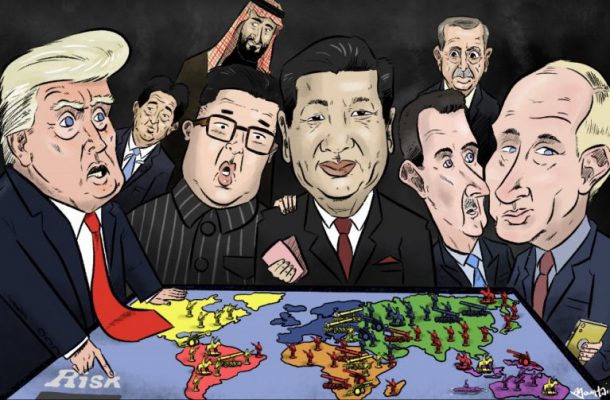2025 will be like 2019 – only more so

For ASPI’s 2019 conference, ‘War in 2025’, I was asked to identify the geopolitical realities that will shape the world of that year. Here I outline some of the strategic constants which—barring major catastrophes—will still most likely be in place in six years’ time.
In 2025, Xi Jinping and Vladimir Putin will likely still be in power. They are young enough and secure enough to anticipate having a decade or more time at the top. Donald Trump won’t be. If Trump wins a second term it will end in a handover to a new president in January 2025.
But it’s likely that the Trump effect will still be a powerful factor in America’s international engagement. I don’t see the United States swinging back to liberal internationalism and multilateral engagement in five or six years.
In Asia across the democracies, I would judge that by 2025 we will have seen a substantial number of leadership changes. For reasons of age or politics or constitutional limits, it’s very unlikely that we’ll see Abe, Modi, Widodo, Mahathir, Duterte and Prime Minister Lee of Singapore leading their parties and countries in that year.
In Australia there are some political certainties too. There will be at least two federal elections between now and then: most likely in 2022 and in 2025. The historical record suggests that we’ll see significant changes of personality.
If you cast back six years to the first Abbott ministry sworn in in September 2013, only four of the 19 cabinet ministers are still in office—Morrison, Dutton, Cormann and Hunt. We change leaders quickly.
Overall, the key message is that the political leaderships of the autocracies will probably look more stable. By contrast, the democracies will look like revolving doors, even where politics is working well.
In many of the consequential democracies, including Canada, France and the UK, we are seeing a succession of one-hit wonders and, in Germany, the end of a stable long-term government.
Politics is likely to continue to fray in the democracies. In the last decade and a half, the trend away from mainstream political parties focused on managing the centre has given way to splinter groups on the more extreme edges of politics. This tends to weaken centrist consensus politics and makes it harder for governments to keep coalitions and stay in power.
On the other hand, over the next five years I see oppression increasing in authoritarian regimes like Russia and China. They can do this because new technology enables more centralised control and more intrusive reach into people’s lives.
Applying more control is how oppressive regimes survive when their populations start to have rising expectations of wealth and better access to information.
That means we’ll see a growing risk to political stability in areas around the borders of authoritarian states, particularly areas in which those states in past eras had some political sway over what happened on their peripheries.
Hong Kong, Taiwan, the East and South China Seas, Ukraine, the Baltic States, and the former Soviet states—as well as Syria and Iran— will be the regions and countries where the authoritarian states with growing military power will be testing the boundaries of their coercive influence.
Why should authoritarian states bother to encroach on their neighbours? Because nearby democracies of similar people are threatening and because nationalism and military overconfidence tend to win out against pragmatism.
The questions for distracted and internally riven democracies will be to what extent they care about such developments and whether they are prepared to step in to underwrite the security of these states on the boundaries.
Another feature that’s likely to become more pronounced in the next half decade will be the closing of a technology gap and a related but separate military capability gap between authoritarian regimes and the developed democracies.
Technology in areas such as 5G immediately, but also artificial intelligence and machine learning, autonomous systems, quantum computing and the rest, are rapidly emerging as the new cold war fault line in global politics.
To put it bluntly, in the time frame we are talking about, the future cooperation of the Five Eyes partnership—and a handful of extra countries that one might call the ‘consequential democracies’—will really be determined by separate national decisions on 5G and associated technology.
One shouldn’t underestimate how painful this technological divide will be for countries and companies that right now straddle that fault line. But ultimately countries will gravitate to promote their core national security interests rather than, for example, cheap technology.
On defence policy more specifically, my surmise is that the democracies, without any real coordination, will become more pressured to speed up defence equipment acquisitions and to increase defence spending. We are certainly seeing this in the Scandinavian countries, for example.
This will increasingly be a question for Australia. As a result of decisions over the past few years, the design of the ‘future’ Australian Defence Force is largely known. There will be incremental adjustments and improvements over time, hopefully harnessing emerging technologies, but the broad outline of platform numbers and designs has been determined.
But the future force is precisely that: in the future, sometime in the late 2030s for many key platforms. Where strategic developments will force more urgent thinking is in the readiness, shape and capabilities of the current force, the ADF that we may have to use for our security at any point over the coming few years.
In summary, over the next five years what I see are a series of continuing trends that don’t really help those countries wanting to promote an international rules-based system.
The rise of powerful authoritarian states with growing military power; the drift of weakly led and fragmenting democracies, forever looking the other way when it comes to resisting the bad behaviour of revisionist powers; and the search for technology that confers a decisive strategic advantage—these trends irresistibly suggest a global situation that looks similar to the second half of the 1930s.
Could this analysis be wrong? Absolutely! I very much hope that I’m misreading the signals. But for a different scenario to eventuate in 2025 we must identify forces that point to a reversal of the fundamental strategic forces in operation right now.
Perhaps ASPI’s conference will identify some points of light, but it would be foolish to assume that more positive trends will simply emerge out of nowhere to prevent the drift to conflict in coming years.
This article is an edited version of remarks delivered by ASPI’s executive director at the opening session of ASPI’s ‘War in 2025’ conference. It was published by The Strategist.
Peter Jennings is the Executive Director of the Australian Strategic Policy Institute. He was Chief of Staff to the Minister for Defence from 1996 to 1998, Senior Adviser for Strategic Policy to the Prime Minister from 2002 to 2003 and Deputy Secretary for Strategy in the Defence Department from 2009 to 2012.











